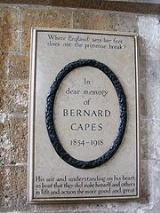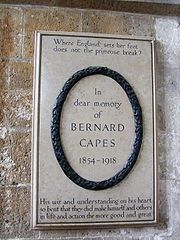
Bernard Capes
Encyclopedia
Bernard Edward Joseph Capes (August 30, 1854 – November 2, 1918) was an English
author.
, one of eleven children: his elder sister, Harriet Capes (1849-1936), was a noted translator and author of more than a dozen children's books. His grandfather, John Capes, had converted to Roman Catholicism, so Capes was brought up a Catholic, and educated at the Catholic college Beaumont College
. However, he rapidly 'gave this up'.
Capes was a prolific Victorian
author, publishing more than forty volumes - romances, mysteries, poetry, history - together with many articles for the magazines of the day. His early writing career was as a journalist, later becoming editor of a paper called The Theatre, which was well known in late nineteenth century London. Other magazines for which Capes wrote included Blackwood's, Butterfly, Cassell's, Cornhill Magazine
, Hutton's Magazine, Illustrated London News
, Lippincott's, Macmillan's Magazine
, Literature, New Witness, Pall Mall Magazine, Pearson's Magazine
, The Idler
, The New Weekly, and The Queen
.
He finally committed to writing novels full-time, taking around four months for each novel. On several occasions he had two or three novels published in the same year - and even four in 1910. His first success came in 1897, when he entered a $30,000 competition for new authors sponsored by the Chicago Record. He was awarded second prize for The Mill of Silence, published by Rand, McNally that year. The following year the Chicago Record ran the competition again, and this time Capes won it with The Lake of Wine, published by Heinemann (book publisher)
. . He died in the 1918 ’flu epidemic
He died in the 1918 ’flu epidemic
. A memorial plaque commemorating his life is in Winchester Cathedral
(where he worked in the years leading up to his death), affixed to the wall by the door which leads to the crypt.
Capes' son Renalt Capes, and grandson Ian Bernard Graham Burns, are also published authors.
England
England is a country that is part of the United Kingdom. It shares land borders with Scotland to the north and Wales to the west; the Irish Sea is to the north west, the Celtic Sea to the south west, with the North Sea to the east and the English Channel to the south separating it from continental...
author.
Biography
Capes was born in LondonLondon
London is the capital city of :England and the :United Kingdom, the largest metropolitan area in the United Kingdom, and the largest urban zone in the European Union by most measures. Located on the River Thames, London has been a major settlement for two millennia, its history going back to its...
, one of eleven children: his elder sister, Harriet Capes (1849-1936), was a noted translator and author of more than a dozen children's books. His grandfather, John Capes, had converted to Roman Catholicism, so Capes was brought up a Catholic, and educated at the Catholic college Beaumont College
Beaumont College
Beaumont College was a Jesuit public school in Old Windsor, Berkshire, England. In 1967 the school closed. The property became a conference centre, and from 2008 an hotel.-History of the estate:...
. However, he rapidly 'gave this up'.
Capes was a prolific Victorian
Victorian literature
Victorian literature is the literature produced during the reign of Queen Victoria . It forms a link and transition between the writers of the romantic period and the very different literature of the 20th century....
author, publishing more than forty volumes - romances, mysteries, poetry, history - together with many articles for the magazines of the day. His early writing career was as a journalist, later becoming editor of a paper called The Theatre, which was well known in late nineteenth century London. Other magazines for which Capes wrote included Blackwood's, Butterfly, Cassell's, Cornhill Magazine
Cornhill Magazine
The Cornhill Magazine was a Victorian magazine and literary journal named after Cornhill Street in London.Cornhill was founded by George Murray Smith in 1860 and was published until 1975. It was a literary journal with a selection of articles on diverse subjects and serialisations of new novels...
, Hutton's Magazine, Illustrated London News
Illustrated London News
The Illustrated London News was the world's first illustrated weekly newspaper; the first issue appeared on Saturday 14 May 1842. It was published weekly until 1971 and then increasingly less frequently until publication ceased in 2003.-History:...
, Lippincott's, Macmillan's Magazine
Macmillan's Magazine
Macmillan's Magazine was a monthly British magazine from 1859 to 1907 published by Alexander Macmillan.The magazine was a literary periodical that published fiction and non-fiction works from primarily British authors. Thomas Hughes had convinced Macmillan to found the magazine. The first editor...
, Literature, New Witness, Pall Mall Magazine, Pearson's Magazine
Pearson's Magazine
Pearson's Magazine was an influential publication which first appeared in Britain in 1896. It specialised in speculative literature, political discussion, often of a socialist bent, and the arts. Its contributors included Upton Sinclair, George Bernard Shaw, Maxim Gorky and H. G...
, The Idler
The Idler
There have been three British publications called The Idler:* The Idler , a series of essays by Samuel Johnson and his contemporaries.* The Idler , a literary and humorous magazine started by Jerome K...
, The New Weekly, and The Queen
Queen (magazine)
Queen magazine was a British society publication established by Samuel Beeton in 1861. In 1958, the magazine was sold to Jocelyn Stevens, who dropped the prefix "The" and used it as his vehicle to represent the younger side of the British Establishment, sometimes referred to as the "Chelsea Set"...
.
He finally committed to writing novels full-time, taking around four months for each novel. On several occasions he had two or three novels published in the same year - and even four in 1910. His first success came in 1897, when he entered a $30,000 competition for new authors sponsored by the Chicago Record. He was awarded second prize for The Mill of Silence, published by Rand, McNally that year. The following year the Chicago Record ran the competition again, and this time Capes won it with The Lake of Wine, published by Heinemann (book publisher)
Heinemann (book publisher)
Heinemann is a UK publishing house founded by William Heinemann in Covent Garden, London in 1890. On William Heinemann's death in 1920 a majority stake was purchased by U.S. publisher Doubleday. It was later acquired by commemorate Thomas Tilling in 1961...
. .

Spanish flu
The 1918 flu pandemic was an influenza pandemic, and the first of the two pandemics involving H1N1 influenza virus . It was an unusually severe and deadly pandemic that spread across the world. Historical and epidemiological data are inadequate to identify the geographic origin...
. A memorial plaque commemorating his life is in Winchester Cathedral
Winchester Cathedral
Winchester Cathedral at Winchester in Hampshire is one of the largest cathedrals in England, with the longest nave and overall length of any Gothic cathedral in Europe...
(where he worked in the years leading up to his death), affixed to the wall by the door which leads to the crypt.
Capes' son Renalt Capes, and grandson Ian Bernard Graham Burns, are also published authors.
Works
(Information supplied by Capes's grandson Ian Bernard Graham Burns)- The Haunted Tower (as ‘Bevis Cane’), 1888
- The Missing Man (as ‘Bevis Cane’), Eglington & Co, 1889
- The Mill of Silence, Rand, McNally & Company, Chicago, 1897
- The Lake of Wine, Heinemann, 1897
- Adventures of the Comte de Muette, William Blackwood and Sons, Edinburgh, 1898
- The Mysterious Singer, J.W. Arrowsmith,
- Our Lady of Darkness, Wm Blackwood, 1898
- At a Winter’s Fire, Arthur Pearson (Re-issued, 1978, by Ayer Co Publishing (USA), 1899
- From Door to Door, Wm Blackwood, 1900
- Love Like a Gypsy, Archibald Constable & Co, Westminster, 1901
- Plots, Methuen & Co, London, 1902
- A Castle in Spain, Smith, Elder & Co, London, 1903
- The Secret in the Hill, Smith, Elder & Co, London, 1903
- The Extraordinary Confessions of Diana Please,
- A Jay of Italy, Methuen, 1905
- The Romance of Lohengrin, Dean and Son, 1906(?)
- Bembo: A Tale of Italy, Dutton & Co., NY, 1906
- Loaves and Fishes (2nd edition 1906), 1906
- The Great Skene Mystery, Methuen, 1907
- The House of Many Voices,
- The Green Parrot, Smith, Elder & Co, 1908
- Amaranthus: A Book of Little Songs, T. Fisher Unwin, 1908
- The Love Story of St Bel, 1908
- Why Did He Do It?, 1910
- Historical Vignettes, 1st Series, T. Fisher Unwin, 1910
- Jemmy Abercraw, Methuen, 1910
- Gilead Balm, T. Fisher Unwin, 1911
- Jessie Bazley, Constable and Company, London, 1912
- Historical Vignettes, 2nd Series, Sidgwick & Jackson, 1912
- The Pot of Basil, Constable and Company, 1913
- Bag and Baggage, Constable, 1913
- The Story of Fifine, Constable (re-issued 1919), 1914
- The Fabulists, 1915
- Moll Davis, George Allen & Unwin, 1916
- If Age Could, Duckworth and Co, London, 1916
- Where England Sets Her Feet,
- The Will and the Way,
- A Fool’s Passion and Other Poems,
- The Skeleton Key, W. Collins Sons, London, 1919

